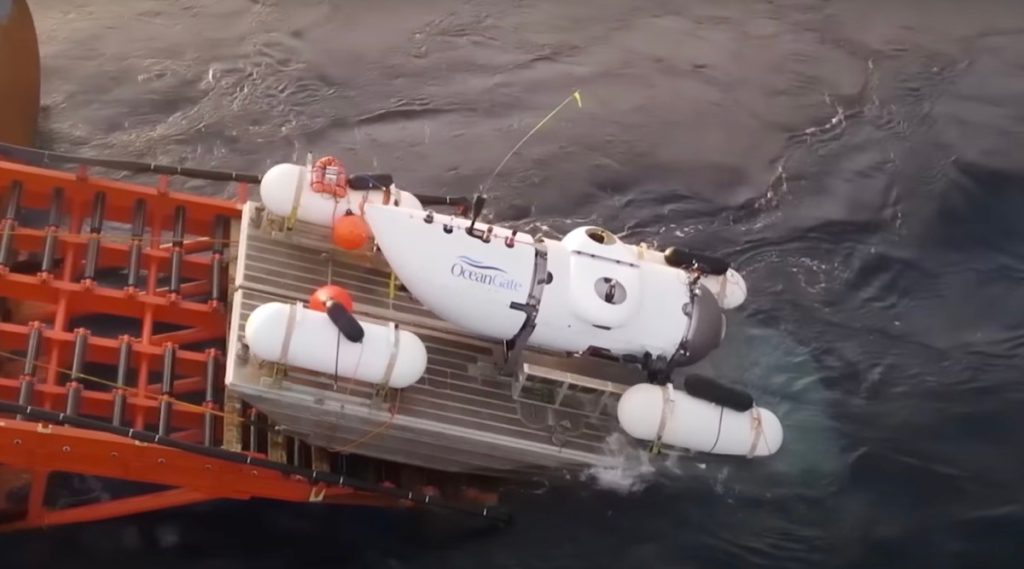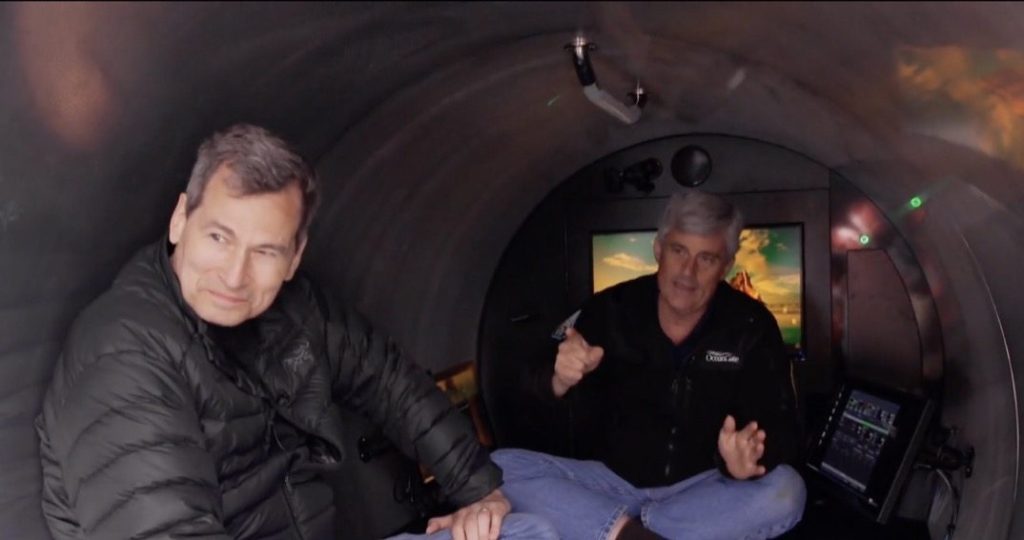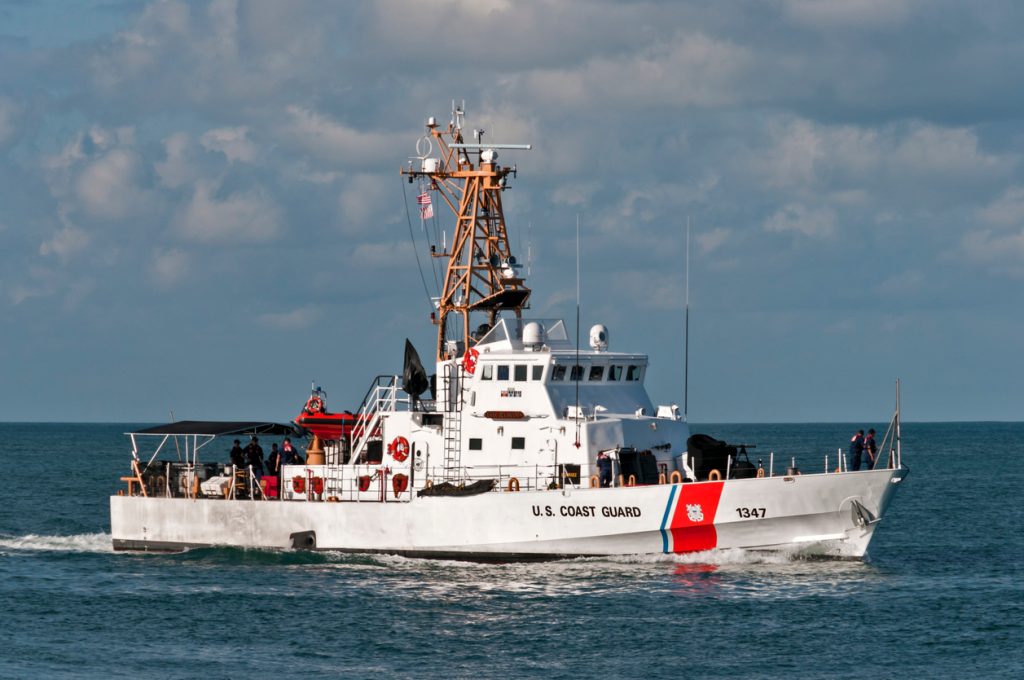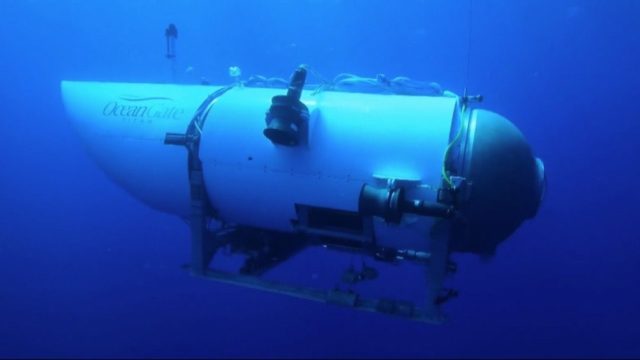Search Underway for Missing Titanic Submarine—What It's Like Inside
The Coast Guard is looking for the submersible, which was carrying five people when it disappeared.
It's been over a century since the RMS Titanic sank during its infamous maiden voyage. But the ship and the tragedy that claimed roughly 1,500 lives have remained a point of cultural fascination ever since, inspiring exhibits, books, and one of the most successful films of all time. Researchers have also continued to explore the wreck site, using special submersibles that carry them to incredible depths to the bottom of the North Atlantic. But now, the search is underway for a submarine ferrying a group of sightseers to the Titanic that went missing shortly after beginning its journey. Read on to see what the unique vessel is like inside and how the hunt for the submersible is progressing.
READ THIS NEXT: Expert Shares What Not to Do When You See a Snake After Being Bitten 50 Times.
A deep sea submersible on its way to the Titanic wreck has gone missing with five people aboard.

On June 18, a submersible called Titan launched a research expedition to visit and map the Titanic shipwreck off the coast of Newfoundland, Canada. But just under two hours into its trek to the site roughly 12,500 feet below the surface, it lost contact with its support vessel and has remained missing ever since, The New York Times reports.
The specialized submersible is operated by OceanGate, a company that offers dives to the famed ocean liner's resting place, as well as to other shipwrecks and deep ocean canyons. Passengers include guests who pay upwards of $250,000 for the opportunity to ride along on missions in the vessel, per The Times.
On its website, the company touts the unique vessel as a "combination of ground-breaking engineering and off-the-shelf technology" that gives it "a unique advantage over other deep diving subs," allowing it to reach depths of 13,123 feet.
In a press conference, Rear Admiral John Mauger, a commander for the U.S. Coast Guard, said the Titan was carrying five people at the time of its disappearance and could sustain emergency life support for 70 to 96 hours, USA Today reports.
Reporters have said the submersible feels "cramped and small" inside.

Besides its ability to reach impressive depths, Titan is also unique in the way it's built. With a hull made of carbon fiber and titanium, the 22-foot-long submersible is the only vessel that can reach the Titanic—but doesn't sport all the lights and screens you might expect on such a specialized piece of equipment. According to a Nov. 2022 report by CBS News, it has about "as much room as a minivan" and has just one illuminated button.
Other reporters who've been aboard the submersible have commented on its small size. "It's this tiny vessel, quite cramped and small," Gabe Cohen, a reporter, told CNN of a visit he took in 2018. "You have to sit inside of it, shoes off… It is operated… by a gaming controller, what essentially looks like a PlayStation controller," he explained.
But despite the vessel's unique design, its operators assured that it was nothing short of safe. "The pressure vessel is not MacGyver at all, because that's where we worked with Boeing and NASA and the University of Washington," Stockton Rush, CEO of OceanGate, told CBS News Sunday Morning last year. "Everything else can fail, your thrusters can go, your lights can go. You're still going to be safe."
RELATED: For more up-to-date information, sign up for our daily newsletter.
The U.S. Coast Guard is now trying to locate the vessel in a remote part of the ocean.

Now, authorities are actively searching for the missing submersible using multiple tactics. The U.S. Coast Guard said it was working closely with Canadian maritime search crews by launching aircraft to conduct scans to see if the vessel had resurfaced. Meanwhile, boats are using sonar and deploying sonar buoys to help locate Titan, according to The Times.
During an interview with ABC's Good Morning America on June 20, Mauger said that "folks have been working around the clock to mobilize gear to get it to the site and to participate in the search for this submersible." He added that the Coast Guard had already covered an area "about the size of Connecticut."
In a statement released on June 19, OceanGate said: "Our entire focus is on the crew members in the submersible and their families. We are deeply thankful for the extensive assistance we have received from several government agencies and deep sea companies in our efforts to reestablish contact with the submersible."
Experts warn the search could prove to be incredibly difficult.

Unfortunately, experts are already cautioning that undertaking such search and rescue missions is an arduous undertaking. This is made especially difficult since the vessel has lost communication abilities.
"As there is no tether between the Titan and the support surface ship, the only way to communicate or detect from the surface is through the seawater," Eric Fusil, a submarine expert and associate professor at the University of Adelaide, told CNN. He explained that open-air searches using sonar became more difficult underwater, as "spotlight or laser beams are absorbed within a few meters."
If the vessel is located on the bottom of the ocean, bringing it and the crew safely back to the surface would require a difficult and unprecedented rescue operation.
"While the submersible might still be intact, if it is deeper than more than 200m (656ft) there are very few vessels that can get that deep, and certainly not divers," Alistair Greig, PhD, a professor of marine engineering from University College London, told the BBC. "The vehicles designed for navy submarine rescue certainly can't get down to anywhere near the depth of the Titanic."






















